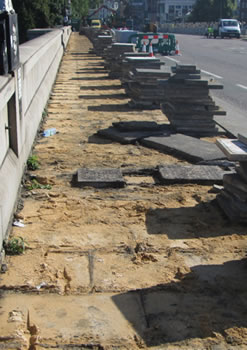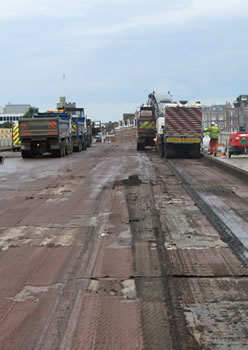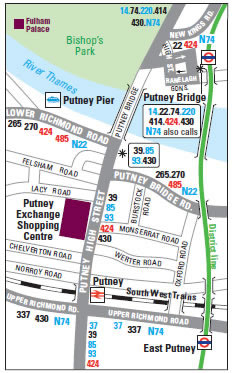Putney Bridge Repairs Update
One week in the council reports that the works are progressing well.
The old road surface has been removed along with the paving and some of the kerb stones on the western footway.

This has exposed the old waterproofing material which needs replacing if the bridge is to be protected from water penetration. Engineers can also now inspect the underlying bridge deck and check what repairs are needed before the new waterproof membrane is laid on top.
 The removal of the tarmac road surface was expected to continue over the whole weekend but was actually completed on Saturday morning.
The removal of the tarmac road surface was expected to continue over the whole weekend but was actually completed on Saturday morning.
In addition all the ornate Victorian lamp columns have now been removed from the bridge parapet and taken to a specialist firm of restorers who will carry out expert repairs and refurbishments. Temporary lighting has been installed until they are ready to be put back.
Work has also begun on the refurbishment of the subway on the northern side of the bridge. Its brickwork, which has suffered from the impact of water penetration over the years will be fixed while the lighting will be upgraded and repairs carried out to its steps.
In the coming days all the remnants of the existing waterproofing layer will be removed and the bridge deck will be “grit-blasted” to remove any solvent residues which could compromise the new membrane. Additional drainage measures will also be introduced under the western footpath while additional lighting will be placed on the eastern footpath in response to requests from pedestrians.
 Transport spokesman Cllr Jonathan Cook said:
Transport spokesman Cllr Jonathan Cook said:
“The works are progressing well so far and we will be looking to keep this momentum going to ensure that the bridge does not have to remain closed for a single minute longer than is necessary.”
The bridge closed last week to all vehicle traffic, including buses, for approximately three months. This is to enable £1.5m worth of repairs to be carried out during the summer months when traffic is at its quietest.
The works also now include a separate project to fix the damage caused earlier this month when a single decker bus crashed into the bridge’s parapet wall. This will involve retrieving six large granite blocks from the riverbed after they were dislodged and fell into the Thames as a result of the collision.
Pedestrians can still walk across the bridge as can cyclists as long as they dismount and wheel their bikes across.
Cyclists who would prefer to cross the Thames on two wheels can still do so if they use the rail bridge that links Deodar Road with Putney Bridge tube station. To make this task easier, the council has just gained permission from London Underground – the bridge’s owners - to install a cycle rail on the stairs so that bikes can be wheeled up onto the bridge instead of being carried. This work will be completed shortly.
 For the duration of the repairs buses will operate a shuttle service from both ends of Putney Bridge. This means that passengers will have to cross the bridge on foot and get on another bus to continue their journeys. Transport for London has confirmed that people only need to pay one fare for the two legs of their journey.
For the duration of the repairs buses will operate a shuttle service from both ends of Putney Bridge. This means that passengers will have to cross the bridge on foot and get on another bus to continue their journeys. Transport for London has confirmed that people only need to pay one fare for the two legs of their journey.
Passengers who either use a travelcard or a concessionary card like a Freedom Pass can walk across the bridge and catch a bus as normal.
Anyone using Oyster pay-as-you-go or a contactless payment card should obtain a ‘transfer voucher’ from the bus driver or a special ‘transfer card’ from dedicated members of staff. Passengers with these will not have to pay again when they embark on the second leg of their journeys.
Transfer cards and vouchers can be used in conjunction with an Oyster PAYG or Contactless payment card which has been validated within 60 minutes on a previous bus journey on routes 14, 22, 39, 74, 85, 93, 220, 265, 270, 424, 430, N22 and N74. Passengers who obtain a transfer card can use it throughout the closure and will not need to obtain a voucher from the driver on each occasion.
Additional TfL staff are available on both sides of the bridge to help direct passengers, issue “transfer cards” and answer any questions about local bus services.
Details of the affected bus routes, along with maps showing where bus stops have been re-postioned, can be found at www.tfl.gov.uk/putney-bridge-closure.
Motorists will need to find alternative routes and are being urged to allow plenty of extra time for their journeys. Up-to-the-minute travel alerts will be available through the @tfltrafficnews twitter feed and on TfL’s website at www.tfl.gov.uk/trafficnews.
July 22, 2014
Related links
|
